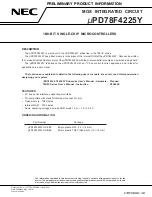
Section 5: Programming
If the zone is disarmed and placed in the tamper or fault state, trouble beeps sound on all system keypads until a key is
pressed on each partition. A zone tamper is sent to the monitoring station if programmed. If the zone is armed and a tamper
is activated, the tamper alarm and zone alarm are logged and transmitted.
OFF: All zones must have a 5.6KΩ resistor. If the zone is shorted or open, it is in the tripped state. If the zone is open and pro-
grammed as a fire zone, it is in the trouble state. The EOL and DEOL zone attributes override this system option.
Note:
Zone Faults (Supervisories) on wireless zones do not cause an audible alarm while armed.
3 – Show All Troubles When Armed
ON: The Trouble LED illuminates when troubles are present on the system in both the armed and disarmed state.
OFF: The Trouble LED illuminates for all troubles while disarmed, but only for Fire Troubles while armed.
4 – Tamper/Faults Do Not Show As Open
ON: The zone does not show open if the zone is in the tamper or fault states. Only the Trouble LED illuminates.
OFF: The respective zone LED shows open if the zone is in the tamper or fault states. The Trouble LED also illuminates.
5 – Auto-Arm Schedule in [*][6]
ON: The auto-arm schedules ([151] - [158]) are accessible via [*][6] as well as Installer Programming.
OFF: The auto-arm schedules ([151] - [158]) are only accessible to installers via Installer Programming.
Note:
This toggle controls access for all eight partitions.
6 – Audible Exit Fault
ON: If a delay type zone is violated after the exit delay has expired, an entry delay warning is sounded through the keypad
and siren indicating that an improper exit was made. If the alarm system is disarmed within the entry delay period no signal
is sent.
OFF: The entry delay warning is sounded only through the keypad.
7 – Event Buffer Follows Swinger
ON: Once an event reaches its swinger shutdown limit programmed in "[377] Communication Variables" on page 123, it will
no longer log events to the event buffer until the swinger shutdown is reset. This avoids filling the event buffer with false
events.
OFF: The event buffer continues to log events to the buffer even after the event has gone into swinger shutdown.
8 – Temporal Three Fire Signaling
ON: All fire bells sound in the temporal three pattern. Cadence is as follows: (500ms ON, 500ms OFF, 500ms ON, 500ms
OFF, 500ms ON, 1.5 sec. OFF).
OFF: All fire bells will sound with the standard 1 second on/1 second off fire bell cadence.
Note:
Must be on for UL/ULC installations.
[014] System Option 2
1 – Bell Squawk
ON: The siren emits a single squawk when armed in any manner, including Auto-arm, and a double squawk when disarmed.
When the system is disarmed, the siren emits a series of three squawk pairs to indicate alarms in memory.
OFF: The siren does not squawk when arming or disarming.
NA
Note:
For UL/ULC, must be enabled if wireless keys are used with the alarm system.
2 – Bell Squawk on Auto-Arm
ON: The siren squawks once every 10 seconds during the auto-arm pre-alert time.
OFF: The siren does not squawk during auto-arm pre-alert.
3 – Bell Squawk On Exit
ON: The siren squawks once per second during exit delay, changing to 3 squawks per second for the final 10 seconds.
OFF: The siren does not squawk for exit delay conditions.
4 – Bell Squawk On Entry
ON: The siren pulses with the same timing as the keypad buzzer during entry delay, changing to 3 squawks per second for
the final 10 seconds.
OFF: The siren does not activate during entry delay.
- 102 -
















































